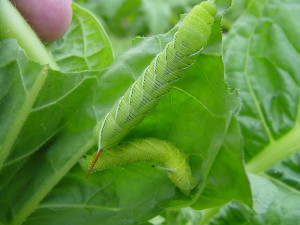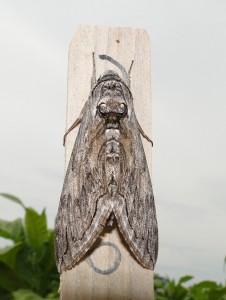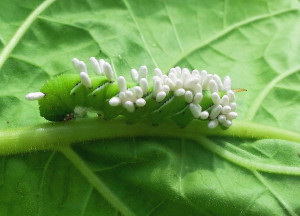Insects – Tobacco and Tomato Hornworm
go.ncsu.edu/readext?66325
en Español / em Português
El inglés es el idioma de control de esta página. En la medida en que haya algún conflicto entre la traducción al inglés y la traducción, el inglés prevalece.
Al hacer clic en el enlace de traducción se activa un servicio de traducción gratuito para convertir la página al español. Al igual que con cualquier traducción por Internet, la conversión no es sensible al contexto y puede que no traduzca el texto en su significado original. NC State Extension no garantiza la exactitud del texto traducido. Por favor, tenga en cuenta que algunas aplicaciones y/o servicios pueden no funcionar como se espera cuando se traducen.
Português
Inglês é o idioma de controle desta página. Na medida que haja algum conflito entre o texto original em Inglês e a tradução, o Inglês prevalece.
Ao clicar no link de tradução, um serviço gratuito de tradução será ativado para converter a página para o Português. Como em qualquer tradução pela internet, a conversão não é sensivel ao contexto e pode não ocorrer a tradução para o significado orginal. O serviço de Extensão da Carolina do Norte (NC State Extension) não garante a exatidão do texto traduzido. Por favor, observe que algumas funções ou serviços podem não funcionar como esperado após a tradução.
English
English is the controlling language of this page. To the extent there is any conflict between the English text and the translation, English controls.
Clicking on the translation link activates a free translation service to convert the page to Spanish. As with any Internet translation, the conversion is not context-sensitive and may not translate the text to its original meaning. NC State Extension does not guarantee the accuracy of the translated text. Please note that some applications and/or services may not function as expected when translated.
Collapse ▲Biology
Tobacco feeding hornworms include 2 species, the tobacco hornworm (Manduca sexta) and the tomato hornworm (Manduca quinquiemaculata). These species are biologically similar but easily distinguished from one another both as larvae and adults. Larval tobacco hornworms have 7 diagonal stripes on each side and a red posterior horn, while larval tomato hornworms have 8 chevrons on each side and a bluish black horn. Tobacco hornworm moths have 6 orange spots on their abdomen, and tomato hornworm moths have 5 spots. The pupae of both species are dark brown and have a handle-like tongue case on the exterior. Hornworms overwinter as pupae in the soil. Adults begin to emerge in early June, and most of the damage occurs in July and later. Two to three hornworm generations occur in North Carolina, depending upon temperature.

Tobacco hornworm (above) and tomato hornworm (below). The tomato hornworm is smaller because it is younger. It can grow to be the size of the tobacco hornworm. Note the differences in their “horns”. Photo: C. Sorenson
Larvae feed on several solenaceous crop species, including tobacco and tomato, as their names suggest. Hornworms progress through 5 to 6 larval instars, with the majority of feeding occurring at fifth or sixth instar. Voracious feeders, two hornworm larvae are capable of completely defoliating a tobacco plant, and moderate populations in a field can result in significant damage.

Tomato hornworm moth. Photo: C. Sorenson
Thresholds and Management
Treatment is justified when one or more hornworms larger than 1 inch and without parasite cocoons (Cotesia congregata) are found per 10 plants checked. Since larvae with parasite cocoons eat much less, they should be counted as 1/5 of a caterpillar, meaning five worms with cocoons equal one healthy worm.
See the North Carolina Agricultural Chemicals Manual for registered materials and use recommendations.
Biological Control
Many native biological control agents feed on hornworms in North Carolina, and these predators and parasites play an active role in reducing the damage hornworms cause. The most obvious hornworm parasitoids are Cotesia congregata. These wasps lay their eggs inside of first to third instar hornworm larvae. As the caterpillars mature, so do the wasp larvae. The wasp larvae then emerge from the fourth or fifth instar hornworm and pupate in white cocoons on their backs. A parasitized hornworm eats roughly 1/5 that of a non parasitized worm.

This hornworm was parasitized by braconid wasps. Although the white bodies look like “eggs”, they are actually tiny wasp cocoons. Photo: Demetri Tsiolkas
Stilt bug adults and nymphs (Jalysus spinosus) feed on both tobacco budworm and hornworm eggs. Many species of wasps (Polistes spp.) use hornworms and other caterpillars as food for their larvae. Tachinid fly parasitiods (Winthemia spp. and Archytas marmoratus) also attack hornworms, killing them in the pupal stage.
More information
How to Identify Two Common Hornworms – NC Small Fruit and Tobacco IPM Channel


